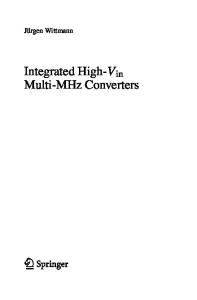Polymorphous Silicon Films Produced in Large Area Reactors by PECVD at 27.12 MHz and 13.56 MHz
- PDF / 124,889 Bytes
- 6 Pages / 612 x 792 pts (letter) Page_size
- 55 Downloads / 374 Views
A5.13.1
Polymorphous Silicon Films Produced in Large Area Reactors by PECVD at 27.12 MHz and 13.56 MHz H. Águas, L. Raniero, L. Pereira, E. Fortunato, P. Roca i Cabarrocas1, R. Martins Departamento de Ciência dos Materiais, Faculdade de Ciências e Tecnologia, Universidade Nova de Lisboa and CEMOP, Campus da Caparica, 2829-516 Caparica, Portugal 2 Laboratoire de Physique des Interfaces et des Couches Minces, Ecole Polytechnique, 91128 Palaiseau Cedex, France ABSTRACT This work refers to a study performed on polymorphous silicon (pm-Si:H) at excitation frequencies of 13.56 and 27.12 MHz in a large area PECVD reactor. The plasma was characterised by impedance probe measurements, aiming to identify the plasma conditions that lead to produce pm-Si:H films. The films produced were characterised by spectroscopic ellipsometry, infrared and Raman spectroscopy and hydrogen exodiffusion experiments, which are techniques that permit the structural characterisation of the pm-Si films and to study the possible differences between the films deposited at 13.56 and 27.12 MHz. Conductivity measurements were also performed to determine the transport properties of the films produced. The set of data obtained show that the 27.12 MHz pm-Si:H can be grown at higher rates with less hydrogen dilution and power density, being the resulting films denser, chemically more stable and with improved performances than the pm-Si:H films grown at 13.56 MHz.
INTRODUCTION Polymorphous silicon (pm-Si:H) [1,2] is a material with very similar properties to amorphous silicon (a-Si:H) but presents a structural difference that consists of having about 2% of small crystallites (2 to 5 nm) imbedded in an amorphous tissue that are identified by the presence of a sharp peak at about 693 K (420ºC) in hydrogen exodiffusion experiments [3]. The peculiar structure of pm-Si allows it to have a low defect density (~ 5×1014 cm-3) and higher resistance to light soaking than a-Si:H films. It also presents better transport properties than a-Si:H, which is highly suitable for the production of optoelectronic devices such as solar cells [3]. pm-Si:H can be deposited in a PECVD diode system similar to that used to deposit a-Si:H. The key factor to deposit pm-Si:H is to keep the plasma close to the so-called α-γ’ transition regime conditions [4] in order to take profit of the small particles 2- 5 nm that are formed in the bulk of the plasma that can be incorporated in the growing film if the residence time of the nanometer particles is bellow the threshold (limit) time for their coagulation [5]. To keep the plasma close to the α-γ’ transition regime, high dilutions of SiH4 in hydrogen (H2), about 3%, are used. Monitoring of the plasma impedance can give information about the α-γ’ transition, since it is known that a change in the plasma impedance occurs and it becomes more resistive [6]. In spite of all the studies performed so far in pm-Si:H, no significant attention has been put on the role of the excitation frequency in the deposition of pm-Si:H or on what happens when t
Data Loading...


